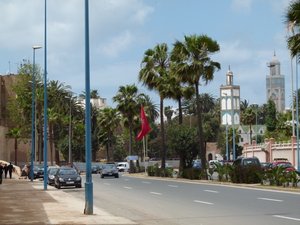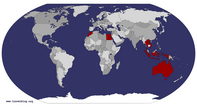Advertisement
Published: April 17th 2012

 Streets of Casablanca
Streets of Casablanca
For the most part streets are dirty and polluted, but those near the popular upmarket port area are wide sweeping boulevardes. A city of contrastsFrom far off, through circuitous corridors, came the scent of citrus-blossom and jasmine, with sometimes a bird’s song before dawn, sometimes a flute’s wail at sunset, and always the call of the muezzin..." ~ Edith Wharton In Morocco
41 hours of hellish flights and airport stopovers that were too long to be comfortable and too short to be of any use except for staring morosely at fellow travellers caught in the same unfortunate predicament.
But there is a price to be exacted for all great experiences...and this was ours.
Having paid our dues we finally landed in Casablanca, in more or less one piece... Scott being "the less" - not being accustomed to long haul flights or such drastic time zone changes. This meant most of our first day in bed recovering, although he did venture out at lunch to see if the "fresh" air and a walk would do him good... Not so much!
So this afforded me some time to research where we have landed ourselves.
The modern city of Casablanca was founded by Berber fishermen in the 10th Century BC and was subsequently used by the Phoenicians, Romans, and the Merenids as a strategic port called Anfa. The Portuguese destroyed it and rebuilt it under the name Casa Branca, only to abandon it after an earthquake in 1755. The Moroccan sultan rebuilt the city as Daru l-Badya and it was given

 The sqala - an 18th century fortified bastion
The sqala - an 18th century fortified bastion
The sqala once protected Casablanca - now a popular Cafeits current name of Casablanca by Spanish traders who established trading bases there. The French occupied the city in 1907, establishing it as a protectorate in 1912 and starting construction of the ville nouvelle, however it gained independence with the rest of the country in 1956.
It is now Morocco's largest city with a population of almost 4 million and also boasts the world's largest artificial port but no ferry service of any kind . Casablanca is also the most liberal and progressive of Morocco's cities. Hip beachside neighbourhoods such as Ain Diab where young men flirt brazenly with scantily-clad women, designer labels are the norm and many young Moroccans speak to each other exclusively in French. Tourist signs invite you to come to Casablanca where your dreams will come true.
But not everyone is living the Casablancan dream. Tens of thousands of rural Moroccans who fled the drought-ravaged interior to find work in the city are struggling under high unemployment rates and expensive housing. The poverty, prevalent in slums on the city's outskirts, has led to high rates of crime, drug use and prostitution. The streets for the most part are dirty, littered and smell of food,

 The entrance to Cafe Maure
The entrance to Cafe Maure
Where the waves once crashed against the crumbling wall, is a popular cafe.One of the few historical sites left in Casablancasweat and urine. Only those streets near the popular port area seemngly sanitised for tourist consumption.
"Casa" is a city that is modern and hip, yet somewhat seedy - a mixed bag of extremes. Walking around the city feels suprisngly safe and relatively easy if you know the general direction you are headed in, even when leading a sick, feverish Scott, who was mumbling apologies to his being for putting himself through his current ordeal! The intent was to find Rick's Cafe. Yes, a cliched, probably over priced, tourist trap but I've admitted the movie has always been an attraction, so it seems silly not to at least get a look!
However its always worthwhile to be open to a sudden and unexpected change of plans. These often provide the most pleasant suprises. Walking along the walls of the old Medina, opposite the Port brought us to a Sqala, an old fortified bastion dating back to the 18th century. There, nestled into it's ochre walls and set into the tranquil gardens of the old town we found a delightful cafe - Cafe Maure, and made the decision to opt for a more traditional choice of menu rather than

 A riot of taste sensations
A riot of taste sensations
colourful, fresh, local ingredientscontinue on to Rick's american fare (we were never going for the food anyway). The flower-draped trellises, rustic decor, colourful mosaics and rendered walls provided peaceful escape from the city.
My memory of 3 years of highschool french afforded me little help in the way of ordering except to understand if we were getting fish, chicken beef or vegetarian. The meals when they came, served in a riot of colourful clay pots, were spiced, warm and plentiful and exactly what we expected from a Moroccan meal. Dips and bread, spiced vegetables to start. The first of many tagines, simpler yet tastier than those cooked back home. Washed down with fresh juice.
Compared to the rest of Morocco there are few attractions to see in Casablanca, but a must is a visit to the Hassan II Mosque. Our travels out of Australia have been predominately to Buddhist, Hindu or non-religious communist countries. This is our first real trip to a predominantly Muslim country. It's a unique experience.
Early morning silence across the city (and the whole country) is broken every day by the call of the Muezzin - the chosen person who recites the Adhan across the streets

 Hassan II Mosque
Hassan II Mosque
One of few Mosques open to non-Muslem visitors, and the third largest mosque in the world.of the city - calling Muslims to prayer. It's a haunting sound, and these days is considered an art form, reflected in the melodious chanting.
But back to the Mosque.
This was our first real activity as part of our Geckos Tour. We'd met the group the night before. One German Stefan out numbered by 8 Australians, travelling in pairs, an older couple Vanessa & Phillip from Hobart; two girls Renae from Melbourne and Sam from Newcastle; another duo of girls from Sydney Alex and Anthea and of course Scott and myself, and of course our guide Said. I couldn't help but think back to our last trip, I don't foresee any Tiger Ted antics or hunting down pool tables late at night aka Asia 2010 - but it's early yet so you never know! (edit: We ended up hunting down Sheesha places instead - but no stuffed toy mascots popping up into photos this time)
We boarded the mini-bus off to the mosque along with the rest of our group.
The Hassan II Mosque in Casablanca was completed in 1993 after great expense and artistic labor, and the result is one of the largest and

 Inside the mosque
Inside the mosque
The walls and columns of the interior are delicately carved in a variety of intricate patterns.most beautiful mosques in the world. Its gleaming newness and tremendous wealth is a stark contrast against the rest of Casablanca
Work on the mosque was commenced on 12 July 1986, and was intended to be completed for the 60th birthday of the former Moroccan king, Hassan II, in 1989. However, the building was not inaugurated until 30 August 1993. During the most intense period of construction, 1400 men worked during the day and another 1100 during the night. 10,000 artists and craftsmen participated in building the mosque. Six thousand traditional Moroccan artisans worked for five years to create the abundant and beautiful mosaic stone and marble floors and columns, sculpted plaster moldings, and carved and painted wood ceilings.
The mosque is open to all Muslims at daily prayer times and for special Friday services. Non-Muslim visitors may enter the mosque on guided tours, which take place several times a day in English. One of the most distinctive features of the mosque, which has been built on an outcrop and reclaimed land, is that almost half of the surface of the mosque lies over the Atlantic Ocean. Reportedly the late King had desired this specific design of floor

 Minaret
Minaret
The mosque boasts the tallest minaret in the worldover the water because of Qur'anic verse which states that Allah's Throne was over water;
".... He it is Who created the heavens and the earth in six Days - and His Throne was over the waters ...."
Part of the mosque's floor is made of glass so worshippers can kneel directly over the sea. Unfortunately, this wonderful feature is mainly for royal use and is off-limits to visitors. Above, an automated sliding roof opens (on special occasions) to the heavens. Thus the faithful of Casablanca can indeed contemplate God's sky and ocean in accordance with Hassan's wishes.
At 689 feet, the Mosque's minaret is the tallest structure in Morocco and the tallest minaret in the world. At night, lasers shine a beam from the top of the minaret toward Mecca, "to point the way to God." The building was designed to withstand earthquakes and has a heated floor and electric doors.
The style of the Hassan II Mosque displays strong Moorish influences, bringing to mind the Alhambra and Mezquita in Spain. Horseshoe arches prevail both outside and in, and the walls and columns of the interior are

 Turkish Baths
Turkish Baths
Under the mosque are turkish baths, according to the guide, they've never been used!delicately carved in a variety of intricate patterns.
There is a huge women's gallery on the right as you face the prayer area, which is beautifully carved of dark wood. The prayer area in the back is spacious and carpeted in red. Downstairs are Turkish-style baths and fountains for washing.
Many people make a quick getaway from Casablanca, heading to Rabat or Fez as soon as they can. Its well worth one or two days in the city however to explore the Old Medina, the mosque and sample some of the cafes and restaurants.
After two days in this vastly contrasting metropolis we were off to the train station. Next stop.... the imperial city of Meknes.
Advertisement
Tot: 0.109s; Tpl: 0.014s; cc: 12; qc: 52; dbt: 0.0526s; 1; m:domysql w:travelblog (10.17.0.13); sld: 1;
; mem: 1.2mb






















